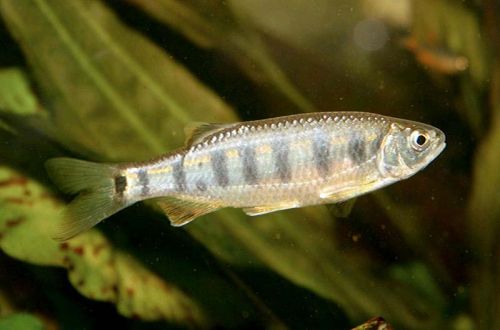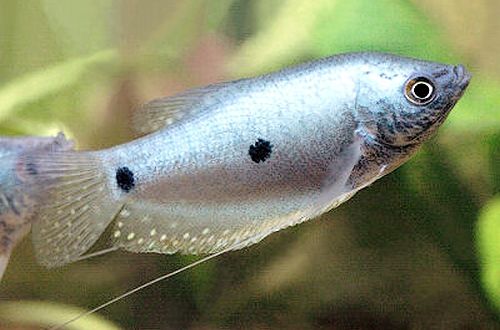
Barilius Dogaringa
Barilius dogarsinghi, scientific name Barilius dogarsinghi, belongs to the family Cyprinidae (Cyprinidae). The fish is named after Sardar Dogar Singh, a prominent statesman, philanthropist from the state of Manipur, India. He organized and co-financed several major scientific expeditions in the 1920s, during which new species of animals and plants were discovered, including the fish Barilius Dogaringa.

Contents
Habitat
The fish inhabits the vast Chindwin River basin in the northeastern regions of India and western Myanmar. It occurs in sections of rivers flowing through hilly, sometimes mountainous areas. A typical biotope is a full-flowing stream with a fast current, substrates of stones and boulders.
Description
Adult individuals reach a length of about 8 cm. The back is gray, the abdomen is light silvery. The body has a metallic sheen. The pattern consists of 8–9 dark blue vertical stripes. The mouth has two short antennae.
In males, unlike females, tiny tubercles on the head and orange pigmentation in the lower part of the body may appear on the head during the mating season.
Brief information:
- The volume of the aquarium – from 250 liters.
- Temperature – 18-24°C
- Value pH — 6.0–7.5
- Water hardness – soft to medium hard (2-15 dGH)
- Substrate type — stony
- Lighting – moderate
- Brackish water – no
- Water movement – moderate, strong
- The size of the fish is about 8 cm.
- Food – any food
- Temperament – conditionally peaceful
- Keeping in a group of 5-6 individuals
Maintenance and care, arrangement of the aquarium
It is desirable that the aquarium be designed in such a way as to resemble a section of a turbulent river with a substrate of stones, sand, fine gravel in which several snags are fixed. The pumps and/or efficient internal filters will become the source of the flow.
In such an environment with artificial flow, only unpretentious plant species can successfully grow. For example, anubias, as well as numerous mosses and ferns, are good choices.
Being native to flowing waters, Barilius Dogaringa needs clean, oxygen-rich water. For long-term keeping, it is important to provide enhanced aeration, prevent the accumulation of organic waste and maintain a temperature regime in the range of 18-24 ° C.
In the case of water purification, you should not rely entirely on the filtration system. A prerequisite is the weekly replacement of part of the water with fresh water (30–50% of the volume).
The fish tend to jump out of the aquarium, so a lid must be provided.
Food
In nature, they feed on small invertebrates (insects, crustaceans, faces). They can eat fry on occasion. In the home aquarium, it is recommended to feed a food with a high protein content, combined with live or frozen bloodworms and other similar products.
Behavior and Compatibility
Active fast fish. Barilius Dogaringa can bother slower and smaller species, which will also lose competition for food. As neighbors, it is worth considering moving fish of similar size. It is also necessary to take into account the characteristics of the habitat (strong or moderate current). All this limits the number of compatible species. Good neighbors will be, for example, some Barbs, Loaches, representatives of catfish.





